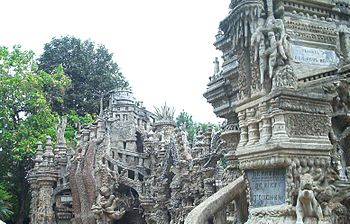Ferdinand Cheval: Difference between revisions
m robot Adding: pl:Ferdinand Cheval |
One long sentence into two shorter ones |
||
| Line 1: | Line 1: | ||
[[Image:Facteur Cheval - Façade Est.jpg|right|thumb|350 px|Cheval's "Palais Idéal". The signs on the right read "Travail d'un seul homme" (Work of only one man) and "Défense de rien toucher" (Do not touch anything).]] |
[[Image:Facteur Cheval - Façade Est.jpg|right|thumb|350 px|Cheval's "Palais Idéal". The signs on the right read "Travail d'un seul homme" (Work of only one man) and "Défense de rien toucher" (Do not touch anything).]] |
||
'''Ferdinand Cheval''' (1836, [[Charmes-sur-l'Herbasse]], [[Drôme]] – 19 August 1924) was a French [[postman]] who spent 33 years of his life building '''Le Palais Idéal''' (the "Ideal Palace") in [[Hauterives]] |
'''Ferdinand Cheval''' (1836, [[Charmes-sur-l'Herbasse]], [[Drôme]] – 19 August 1924) was a French [[postman]] who spent 33 years of his life building '''Le Palais Idéal''' (the "Ideal Palace") in [[Hauterives]]. It is regarded as an extraordinary example of [[naïve art]] architecture. |
||
==Origins== |
==Origins== |
||
Revision as of 21:56, 19 December 2009

Ferdinand Cheval (1836, Charmes-sur-l'Herbasse, Drôme – 19 August 1924) was a French postman who spent 33 years of his life building Le Palais Idéal (the "Ideal Palace") in Hauterives. It is regarded as an extraordinary example of naïve art architecture.
Origins
Ferdinand Cheval lived in Châteauneuf-de-Galaure, in the Drôme département of France. He had left school at the age of 13 to become a baker's apprentice but eventually became a postman.
Palais idéal
Cheval began the building in April 1879. He claimed that he had tripped on a stone and was inspired by its shape. He returned to the same spot the next day and started collecting stones.
For the next 33 years, during his daily mail route, Cheval carried stones from his delivery rounds and at home used them to build his Palais idéal, the Ideal Palace. First he carried the stones in his pockets, then a basket and eventually a wheelbarrow. He often worked at night, by the light of an oil lamp.
Cheval spent the first two decades building the outer walls. The Palace is a mix of different styles with inspirations from the Bible to Hindu mythology. Cheval bound the stones together with lime, mortar and cement.
Burial
Cheval also wanted to be buried in his palace. However, since that is illegal in France, he proceeded to spend eight more years building a mausoleum for himself in the cemetery of Hauterives. Cheval died on August 19, 1924, around a year after he had finished building it, and is buried there.
Recognition
Just prior to his death, Cheval began to receive some recognition from luminaries like André Breton and Pablo Picasso. His work is commemorated in an essay by Anaïs Nin.
In 1969 André Malraux, the Minister of Culture, declared the Palace as a cultural landmark and had it officially protected. Cheval's palace is open every day except Christmas Day and New Year's Day.
Cheval may have been the inspiration for the character of Denny in Chuck Palahniuk's 2001 novel Choke, who gathers a collection of stones which are eventually used, in similar fashion, to build his 'dream home'.
Gallery
See also
External links
- Le Palais Idéal du Facteur Cheval (requires Flash)
- Expo.htm at perso.wanadoo.fr" Expo Coco Peintre du Facteur Cheval-1987 Hauterives France
- Hauterives and Palais Idéal Photogallery
- Album Mon Cheval a French's blog photogallery




